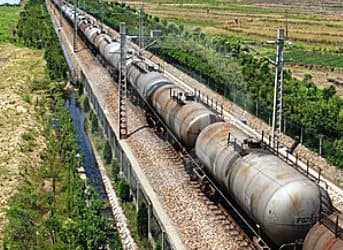Experts from the Canadian rail industry, regulators, and representatives from all levels of government met in Ottawa on Monday to discuss the increasing number of tank car derailments and subsequent explosions that now seem to be almost a regular occurrence. At the top of the agenda was the safety of DOT-111 tank cars, which represent the majority of tank cars operating in North America. This meeting comes just days after a CN train derailed and exploded outside Plaster Rock, New Brunswick.
DOT-111 tank cars are non-pressurized, cylindrical railcars designed to transport a variety of liquids. They are also the most common tank cars in service, representing eighty percent of the Canadian fleet and sixty-nine percent of the American fleet. Of a total 320,000 total tank cars operating in 2013, 265,000 of them were classified as DOT-111. The bulk of these railcars are produced by five large US manufacturers, which turn out between 20,000 and 25,000 per year. However, the demand for these cars far exceeds production and there is currently a backlog of at least 40,000 cars.

Typical DOT-111 Tank Car
The main concern with these tank cars is their tendency to puncture in the event of a crash. This is particularly problematic when these types of tank cars are used to transport crude oil from American shale, which has been proven to be more explosive than traditional crude. Transport Canada has recently announced plans to alter DOT-111 regulations, requiring that all new cars be built with thicker steel, include a reinforced top fitting, and a head protection shield to lessen the risk of puncture.
Related article: Canadian Oil and Gas Train Derails, Catches Fire
While this regulatory shift is a step in the right direction, the proposed regulation does not require that older tank cars be retrofitted to come into line with new regulations, although it does hint that this may be a next step. Malcolm Cairns, consultant with the Canadian Transportation Research Forum, prepared a report on DOT-111 tank cars outlining these safety concerns. According Cairns, approximately, 45,000 tanker cars require retrofitting—a proposal that would take years, remove many tank cars from an already tight market, and cost in excess of $1 billion.
The American railroad industry has expressed support for stricter tank car regulations, but it should be known that railroad companies own fewer than 700 of these tank cars. The vast majority (more than 99%) of the tank car fleet is owned by a wide array of mainly petrochemical shipping firms, which lease the tank cars to rail companies. This is why opposition to regulation will come from companies that, until now, will sound foreign to the discussion surrounding oil transportation. The crude-by-rail debate is more complicated than many believe, involving a host of silent actors that have thus far avoided serious public criticism.
As stated at the outset of this article, stories of exploding trains are becoming far too common. Government and industry must come together in order to lessen the risk of both environmental contamination and harm to human life. This is going to cost money and take time, but the crude-by-rail phenomenon took the industry by storm and regulators are only now beginning to catch up with reality.
ADVERTISEMENT
By. Rory Johnston

















